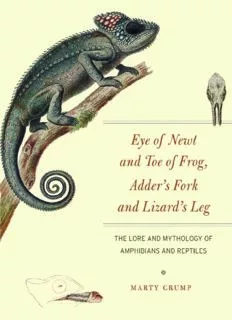
Eye of Newt and Toe of Frog, Adder's Fork and Lizard's Leg: The Lore and Mythology of Amphibians and Reptiles PDF
Preview Eye of Newt and Toe of Frog, Adder's Fork and Lizard's Leg: The Lore and Mythology of Amphibians and Reptiles
Eye of Newt and Toe of Frog, Adder’s Fork and Lizard’s Leg Eye of Newt and Toe of Frog, Adder’s Fork and Lizard’s Leg The Lore and Mythology of Amphibians and Reptiles Marty Crump In collaboration with Danté B. Fenolio The University of Chicago Press : : Chicago and London MARTY CRUMP is currently an adjunct professor of biology at Utah State University and Northern Arizona University; she has been a herpetologist for more than forty-five years. For at least that long, she has been intrigued with the folklore of amphibians and reptiles. She is the author of In Search of the Golden Frog, Headless Males Make Great Lovers, and Sexy Orchids Make Lousy Lovers, all published by the University of Chicago Press, as well as the recent award-winning children’s book, The Mystery of Darwin’s Frog. The University of Chicago Press, Chicago 60637 The University of Chicago Press, Ltd., London © 2015 by The University of Chicago All rights reserved. Published 2015. Printed in the United States of America 24 23 22 21 20 19 18 17 16 15 1 2 3 4 5 ISBN- 13: 978- 0- 226- 11600- 6 (cloth) ISBN- 13: 978- 0- 226- 11614- 3 (e- book) DOI: 10.7208/chicago/9780226116143.001.0001 Library of Congress Cataloging-in-Publication Data Crump, Martha L., author. Eye of newt and toe of frog, adder’s fork and lizard’s leg: the lore and mythology of amphibians and reptiles / Marty Crump; in collaboration with Danté B. Fenolio. pages cm Includes bibliographical references and index. ISBN 978-0-226-11600-6 (cloth: alkaline paper) — ISBN 978-0-226-11614-3 (e-book) 1. Amphibians—Folklore. 2. Amphibians—Mythology. 3. Reptiles—Folklore. 4. Reptiles— Mythology. I. Fenolio, Danté B. (Danté Bruce), author. II. Title. QL644.C73 2015 597.8—dc23 2015012981 ♾ This paper meets the requirements of ANSI/NISO Z39.48- 1992 (Permanence of Paper). Major funding for color throughout was provided by The Ecology Center, Utah State University Additional funding was provided by PARC ARC MCZ, Harvard University Southern Nevada Herpetological Society Evelyn R. Savitzky And by Chicago Herpetological Society East Texas Herpetological Society Tucson Herpetological Society Save the Frogs! Anonymous Nancy Huntly, Thomas E. Lovejoy III, Alan H. Savitzky North Carolina Herpetological Society For Al Contents 1 1 Talk to the Animals 25 2 In the Beginning: Creation Myths 41 3 Snakes: “Good” or “Evil”? 65 4 Songs and Thunderbolts: Frogs, Snakes, and Rain 83 5 A Second Chance: Frogs, Snakes, and Rebirth 99 6 Of Love, Morals, and Death: Amphibians and Reptiles in Folktales 115 7 The Lighter Side: Trickster Tales and “How” and “Why” Stories 131 8 Tailless Wonders, Naked Serpents, and Fire Lizards: Perception of Amphibians through Folk Beliefs vii 155 9 Marshmallow- Eaters, Methuselahs, Spiny- Backs, Were- Lizards, and Protectors: Perception of Reptiles through Folk Beliefs 183 10 Move Aside, Viagra: Reptile Sexual Power 199 11 Pick Your Poison— Blood, Venom, Skin, or Bones: Folk Medicines 217 12 Like a Hell- Broth, Boil and Bubble: Witchcraft and Magic 235 13 “How ’bout Them Toad Suckers”: Other Ways We Use Amphibians and Reptiles 265 14 Singing Tuatara from Their Holes Acknowledgments 289 References 291 Illustration Credits 301 Index 305 viii CoNTENTS 1 Talk to the Animals one thing to remember is to talk to the animals. If you do, they will talk back to you. But if you don’t talk to the animals, they won’t talk back to you, then you won’t understand, and when you don’t understand you will fear and when you fear you will destroy the animals, and if you destroy the animals, you will destroy yourself. —CHIEF DAN GEORGE (1899– 1981), Tsleil- Waututh Nation, North Vancouver, British Columbia O n the other side of the world from British Columbia, an Aboriginal elder from Victoria, Australia, fishes from a riverbank with his young grandson. He begins, “Son, I have much to teach you. The rivers and lakes sustain us. The forest is the resting place of our ancestors and home of the spirits. If the land dies, if the water dries up, we, too, wither away. We de- pend on Rainbow Serpent, who taught us that we must care for the land, the water, and all animals.” He continues: In the beginning, before life on Earth’s surface, Rainbow Serpent and all the other animals slept underground. One day Rainbow Serpent awoke, crawled onto the surface, and surveyed the dry, empty land. She made rain. The rain soaked into the parched land. After years of rain, the water filled the tracks left by Rainbow Serpent’s body and formed rivers, billabongs, and water holes. As she pushed her snout into the earth, Rainbow Serpent formed 1
Description: